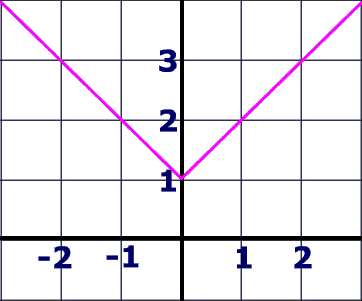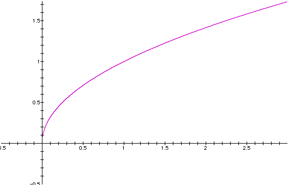Graph Test: Parent Function Quiz!
(152).jpg)
In mathematics, a “parent” function is the simplest function of a family of functions, which preserves the family's definition. In a sense, it is like the control of a function, something with which to compare any other results you acquire from the same function type. Let’s take a look at some examples, should we? See how much you know about them in this quiz!
- 1.
What does a linear function graph look like?
- A.
- B.
- C.
- D.
Correct Answer
A.Explanation
A linear function graph is a straight line that can be represented by the equation y = mx + b, where m is the slope of the line and b is the y-intercept. The slope determines the steepness of the line, while the y-intercept is the point where the line crosses the y-axis. The graph of a linear function is always a straight line because the rate of change between the x and y variables is constant.Rate this question:
-
- 2.
What does an absolute value graph look like?
- A.
- B.
- C.
- D.
Correct Answer
C.Explanation
An absolute value graph is a V-shaped graph that opens upwards or downwards depending on the coefficient of x. It is symmetric with respect to the y-axis and the vertex of the graph is at the origin (0,0). The graph represents the distance from zero, so it is always positive or zero.Rate this question:
-
- 3.
What does a quadratic (Parabola) graph look like?
- A.
- B.
- C.
- D.
Correct Answer
B.Explanation
A quadratic graph, also known as a parabola, is a U-shaped curve. It is symmetric around a vertical line called the axis of symmetry. The vertex of the parabola is the highest or lowest point on the graph, depending on the direction it opens. The shape of the parabola can vary depending on the coefficients of the quadratic equation. If the coefficient of the x^2 term is positive, the parabola opens upwards, and if it is negative, the parabola opens downwards. The steepness of the curve is determined by the coefficient of the x^2 term.Rate this question:
-
- 4.
What does a cubic graph look like?
- A.
- B.
- C.
- D.
Correct Answer
A.Explanation
A cubic graph is a type of graph that represents a cubic function. It is characterized by a curve that is either concave up or concave down, and it can have one or two points of inflection. The graph may also have a local maximum or minimum point, depending on the coefficients of the cubic function. Additionally, the graph can intersect the x-axis at one, two, or three points, depending on the roots of the cubic equation.Rate this question:
-
- 5.
What does a rational graph look like?
- A.
- B.
- C.
- D.
Correct Answer
D.Explanation
A rational graph is a type of mathematical graph that represents a rational function. It typically consists of a curve or line with various branches and asymptotes. The graph may have vertical asymptotes where the function approaches infinity or negative infinity, and horizontal asymptotes where the function approaches a constant value as x approaches infinity or negative infinity. The graph may also have x-intercepts and y-intercepts, which represent points where the function crosses the x-axis or y-axis. Overall, a rational graph can have a variety of shapes and features depending on the specific rational function being represented.Rate this question:
-
- 6.
What does a square root graph look like?
- A.
- B.
- C.
- D.
Correct Answer
C.Explanation
A square root graph is a curve that starts at the origin and gradually increases as the input values increase. The curve becomes steeper as the input values increase, but it never reaches negative values. The graph is symmetrical with respect to the y-axis and has a minimum point at the origin. As the input values approach positive infinity, the graph approaches positive infinity as well.Rate this question:
-
- 7.
What is the formula of a linear graph?
- A.
X3
- B.
X2
- C.
1/x
- D.
F(x)=x
Correct Answer
D. F(x)=xExplanation
The formula of a linear graph is f(x) = x. This means that the value of y (represented by f(x)) is directly proportional to the value of x. As x increases or decreases, y will also increase or decrease in a straight line. This is the simplest form of a linear equation, where the slope of the line is equal to 1.Rate this question:
-
- 8.
What is the formula of a absolute value graph?
- A.
1/x
- B.
|x|
- C.
X2
- D.
F(x)=x
Correct Answer
B. |x|Explanation
The formula for an absolute value graph is represented by |x|. This formula indicates that the graph of the function will be symmetrical around the y-axis, with the vertex at the origin (0,0). The absolute value function returns the distance of a number from zero, disregarding its sign. Therefore, when graphed, it will always result in a V-shaped graph.Rate this question:
-
- 9.
What is the formula of a rational graph?
- A.
1/x
- B.
|x|
- C.
- D.
F(x)=x
Correct Answer
A. 1/xExplanation
The formula of a rational graph is 1/x. This is because a rational function is defined as the division of two polynomial functions. In this case, the numerator is a constant 1 and the denominator is x, resulting in the equation 1/x. This formula represents a graph that has a vertical asymptote at x = 0 and approaches zero as x approaches positive or negative infinity.Rate this question:
-
- 10.
What is the formula of a cubic graph?
- A.
1/x
- B.
|x|
- C.
X3
- D.
F(x)=x
Correct Answer
C. X3Explanation
The formula of a cubic graph is represented by the equation f(x) = x^3. This equation indicates that the graph of the cubic function will have a shape similar to the letter "S" and will include points such as (0,0) and (-1,-1), (1,1), (-2,-8), (2,8), etc. The exponent of 3 in the equation indicates that the function is a cubic function, which means it has a degree of 3. Therefore, the correct answer is x^3.Rate this question:
-
- 11.
What is the formula of a quadratic graph?
- A.
X2
- B.
- C.
|x|
- D.
1/x
Correct Answer
A. X2Explanation
The formula of a quadratic graph is x^2. This is because a quadratic equation is of the form ax^2 + bx + c, where a, b, and c are constants. In this case, since there are no other terms or constants given in the question, the formula of the quadratic graph is simply x^2.Rate this question:
-
- 12.
What is the formula of a square root graph?
- A.
1/x
- B.
- C.
|x|
- D.
X2
Correct Answer
B. XExplanation
The formula for a square root graph is represented by the equation y = √x. In this equation, the variable x represents the input values, and the square root of x represents the corresponding output values, y. The graph of this equation will form a curve that starts from the origin (0,0) and gradually increases as x increases. The graph will never have negative y-values because the square root of a negative number is undefined. Therefore, the correct answer is X.Rate this question:
-
- 13.
The parent function of a ______ function is f(x) = x, which represents a straight line passing through the origin with a slope of 1.
Correct Answer
linear, LinearExplanation
The parent function of a linear function is the most basic form of a linear equation, representing a straight line with a constant slope. Understanding the parent function helps in analyzing and graphing more complex linear equations, as they can be seen as transformations of the parent function.Rate this question:
Quiz Review Timeline +
Our quizzes are rigorously reviewed, monitored and continuously updated by our expert board to maintain accuracy, relevance, and timeliness.
-
Current Version
-
Jan 20, 2025Quiz Edited by
ProProfs Editorial Team -
Nov 08, 2011Quiz Created by
Jaida










